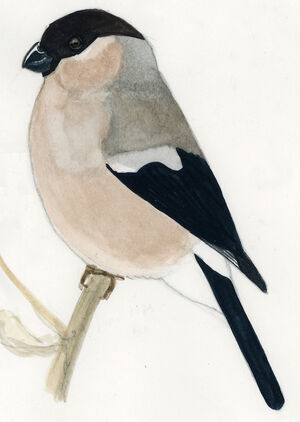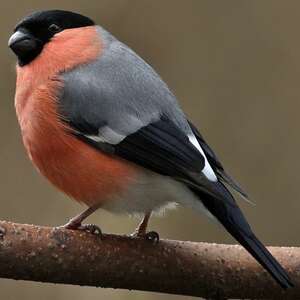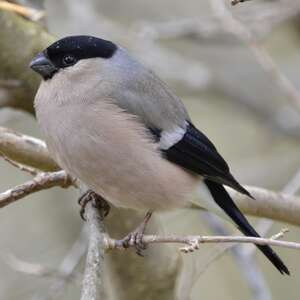Eurasian Bullfinch
Pyrrhula pyrrhula - Bouvreuil pivoine
Identification
The Eurasian Bullfinch is a passerine the size of a sparrow, but more chunky. The adult male of the europaea subspecies is brightly colored. His mantle, back and small and medium coverts are light gray. The rump is white, contrasting with the upper tails and the glossy black tail. The large coverts and remiges are glossy black with blue reflections. The lower parts are bicolored. The throat, chest, flanks and upper abdomen are of a fairly intense pinkish red while the lower belly and undertail coverts are white. The head is massive. Intense black covers the skullcap, the black eyes, the lores and runs down to the chin. The cheeks are concolored with the chest. The black, conical and massive beak seems to be an integral part of the head. The illusion comes from the fact that the curvature of the culmen prolongs that of the skullcap and the edge of the beak merges into the black of the lores. The legs are pinkish-brown. The adult female is similar to the male, but with less vivid colors. The gray ash of the top is replaced by a fairly dull grayish beige and the red of the bottom by a discreet pinkish beige. The juvenile resembles a female without a black skullcap. His plumage is overall warmer, tinged with red. His wingbar is tinged with fawn. Present throughout the northern part of Eurasia, the bullfinch has developed 9 subspecies that differ by fairly noticeable variations in the plumage colors. Thus, the male of the cineracea ssp from the center-east of the continent is entirely gray below, there is no more red. Griseiventris is also very gray below, but has kept red on the sides and bottom of the head.
Subspecific information 10 subspecies
- Pyrrhula pyrrhula pyrrhula (n, sc and e Europe to c Siberia)
- Pyrrhula pyrrhula pileata (British Isles)
- Pyrrhula pyrrhula europaea (w Europe)
- Pyrrhula pyrrhula iberiae (sw France, n Iberian Pen.)
- Pyrrhula pyrrhula rossikowi (ne Turkey and the Caucasus)
- Pyrrhula pyrrhula cineracea (w Siberia and ne Kazakhstan to e Siberia and ne China)
- Pyrrhula pyrrhula caspica (Azerbaijan and n Iran)
- Pyrrhula pyrrhula cassinii (e Siberia)
- Pyrrhula pyrrhula griseiventris (Kuril Is. and n Japan)
- Pyrrhula pyrrhula rosacea (Sakhalin I.)
Foreign names
- Bouvreuil pivoine,
- Camachuelo común,
- dom-fafe-eurasiático,
- Gimpel,
- süvöltő,
- Goudvink,
- Ciuffolotto,
- domherre,
- Dompap,
- hýľ obyčajný,
- hýl obecný,
- Dompap,
- punatulkku,
- pinsà borroner eurasiàtic,
- Dómpápi,
- gil (zwyczajny),
- svilpis,
- kalin,
- Снегирь,
- ウソ,
- 红腹灰雀,
- domherre,
- 歐亞鷽〔紅腹灰雀,灰腹灰雀〕,
Voice song and call
In middle Europe, the common call of the Eurasian Bullfinch is a plaintive iuh of relatively low tone emitted at regular intervals. It is primarily a call used to contact other individuals. However, birds in Northern Europe (ssp pyrrhula) emit a more high pitched and almost raucous hip, that is very different from the previous call. This allows to recognise among wintering Bullfinches those that are from far away. They have been named Trumpeting Bullfinches to distinguish them. The song of the Eurasian Bullfinch is rarely heard and not very elaborate. It is a low and squeaky chatter interspersed with short whistles.
Habitat
The Eurasian Bullfinch is a forest bird preferring clear forests, whether deciduous, coniferous or mixed. It is primarily a bird of plains and foothills, but in the east of its range, it can reach up to 2,500 m and more, for example in Japan. It is mostly the lower herbaceous and shrubby strata that interest it for feeding and nesting. It has adapted secondarily to anthropogenic habitats such as hedgerows, orchards, plantations, parks and gardens, even in towns.
Behaviour character trait
The Eurasian Bullfinch is a quiet and shy bird. It is emotional and ringers know it very well. It should be handled with caution or it could die in the hands of an emotional shock.
During the summer, it is often seen in couples or small family groups. Even in the interseason, there are never large groups, a few tens of birds at most and even rarely. Discreet, the bullfinch usually perches under the cover of trees, its small cries revealing its presence. On the other hand, when he wants to be seen, he willingly perches at the top of the tallest trees, especially if there are dead branches, and his insistent calls are not unnoticed. These are probably rallying cries. The Eurasian Bullfinch willingly feeds on buds in spring, particularly on fruit tree buds. This is why it was once considered an agricultural pest due to damage to trees, real or supposed. During the mating display, the male emphasizes the beautiful colors of his chest and lowers his wings to show his white rump while he struts around the female. The partners then emit soft whistles. Then the male regurgitates seeds into the female's beak. She fluffs her feathers, leans and turns from side to side. All this gesturing is done to strengthen the bonds of the couple. These bonds are strong and it is thought that they last beyond the nesting season until the next one. During breeding, the bullfinch brings food to the chicks in special pockets located at the base of its beak, on either side of the tongue. Most of the other finches store food in their throat.Flight
The Eurasian Bullfinch has a typical finch flight, alternating between flapping sequences and brief wing folds. Its compact silhouette, coupled with its long tail and big head, makes it easy to recognize. Its white rump and typical call help with recognition. Even though it isn't built for long-distance migration, the species is part of the migrating flocks that come to Europe towards the south-west at the end of the summer and in autumn, but usually singly or in very small groups.
Dietfeeding habits
The Eurasian Bullfinch mainly feeds on a variety of seeds ranging from 0.5 to 14mm in size. Smaller seeds come from herbaceous plants near the ground, while bigger ones come from trees like chestnut and conifers (firs and pines).
At the beginning of the season, they enjoy swollen buds from fruit trees, including from orchards. In late season, they are interested in berries growing on trees and shrubs, but not for the pulp that they usually reject, but for the seeds they contain. They also consume some invertebrates, caterpillars, various insects, but this is minor, except for the young birds, which have a predominantly insectivorous diet. Eurasian Bullfinches are usually not fixtures at winter feeding stations. When searching for food, they might adopt acrobatic postures in order to access the desired seeds. They rarely come down to the ground.Reproduction nesting
The Eurasian Bullfinch is a monogamous species. The female has a dominant role in the pairing. The pair usually forms after discreet displays accompanied by small cries.
It seems that it is the male's job to choose the nesting site, while the female is building the nest. The nest is always fairly low (2m or less) in a bush or thicket, occasionally up to 5m high. The bottom of the nest is made of dry twigs. It is generously lined with roots and plant fibers inside. It has the appearance of a mini-corvid or jay nest. In April-May, the female lays 4 to 6 pale blue eggs with light and more distinct blotches of a brown-purple color. Incubation lasts 12 to 14 days, mainly done by the female aided and fed by the male. The chicks are mostly fed with invertebrates, brought by the male in the first days. They leave the nest at 14-16 days old but remain dependent on the adults for another fifteen days or more.Geographic range
The breeding range of the Eurasian Bullfinch extends from the Atlantic to the Pacific across the entire Eurasian continent in temperate latitudes. It is rare in the Mediterranean biome and absent from the grassland heartlands of the continent. Its presence is linked to highland habitats (Southern European, Minor Asian and Caucasian mountains). It is a partial migrant. Birds from the northeast of the area leave the inhospitable breeding sites in winter and return to the southerly non-migrants. Some venture beyond the range to the south but never reaching the African continent, the Arabian Peninsula or the Indian continent.
Threats - protection
IUCN conservation status
concern
in the Wild
threatened
evaluated
Overall, the species is not classified as endangered. Its populations remain substantial. The Eurasian Bullfinch is a regular bird, but never as abundant as the chaffinch for example. The impression of decline felt in France for example is easily explained. With the land management carried out in the last century where they sought to optimize exploitation and yields, it could not have been otherwise. The policy of consolidation has led to the suppression of unimaginable hedgerows, copses and small woods, and small wetlands that have been drained, in short, many refuges for wildlife. The decline of the Eurasian Bullfinch was inevitable. Global warming has also been hard on the species because it is rather northern in affinity. We can reverse the trend by limiting agricultural land, for example by preserving uncultivated strips, or even replanting hedges, managing ecotones such as forest edges, riparian forests, etc. As their maintenance requires time, and thus money, subsidies would have to be allocated.
Sources of information
- IOC World Bird List (v15.1), Gill, F and D Donsker (Eds). 2025-12-07.
- Les passereaux d'Europe, tome 2, P. Géroudet, M. Cuisin
- Birds of the World, The Cornell Lab of Ornithology
- xeno-canto, Sharing bird sounds from around the world,
Other sources of interest
 Specification sheet created on
09/07/2023 by Jean François
Specification sheet created on
09/07/2023 by Jean FrançoisTranslation by AI Oiseaux.net
© 1996-2025 Oiseaux.net
- Accipitriformes
- Aegotheliformes
- Anseriformes
- Apodiformes
- Apterygiformes
- Bucerotiformes
- Caprimulgiformes
- Cariamiformes
- Casuariiformes
- Charadriiformes
- Ciconiiformes
- Coliiformes
- Columbiformes
- Coraciiformes
- Cuculiformes
- Eurypygiformes
- Falconiformes
- Galliformes
- Gaviiformes
- Gruiformes
- Leptosomiformes
- Mesitornithiformes
- Musophagiformes
- Nyctibiiformes
- Opisthocomiformes
- Otidiformes
- Passeriformes
- Pelecaniformes
- Phaethontiformes
- Phoenicopteriformes
- Piciformes
- Podargiformes
- Podicipediformes
- Procellariiformes
- Psittaciformes
- Pterocliformes
- Rheiformes
- Sphenisciformes
- Steatornithiformes
- Strigiformes
- Struthioniformes
- Suliformes
- Tinamiformes
- Trogoniformes


































